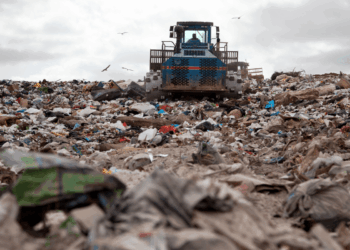Editor’s note: This story has been updated.
Nine workers died in U.S. materials recovery facilities in 2023 and the death rate for refuse and recyclable material collectors jumped more than 80%, according to the latest annual numbers released by the Bureau of Labor Statistics.
The federal agency report highlights a year of backsliding in waste and recycling workplace safety, and industry groups say the numbers reveal an urgent need for safety improvements. The industry increase comes as overall workplace fatalities and fatality rates across the country were down year-over-year.
The nine MRF fatalities is up from seven the prior year, and the collection fatality rate of 41.4 deaths per 100,000 workers is up from 22.6 in 2022, an 83% increase. That placed refuse and recyclable material collection the fourth highest rate of fatal injury across all occupations, behind roofers; fishing and hunting workers; and logging workers.
Deaths in the solid waste collector classification totaled 40 in 2023, three more than in the prior year. Thirty-five of the fatalities were in private-sector collection operations, and five were in the public sector. More than half the fatalities resulted from “transportation incidents,” while four were due to exposure to harmful substances or environments.
Overall, the BLS employment category for waste management and remediation services, which includes workers in collection, landfill operation, hazardous waste and more, recorded 87 fatalities in 2023, up from 61 in that sector the prior year.
“This news sheds light on the critical need for improved infrastructure, including support for automated collections, safety features on vehicles, and other technology that can make a difference in protecting lives,” said Amy Lestition Burke, executive director and CEO of the Solid Waste Association of North America, in a statement.
The National Waste & Recycling Association issued a statement expressing sadness at the rise in fatalities.
“The safety of our industry’s workforce is a top priority for NWRA and its members, and these results do not align with our members’ commitment to safety programs and training,” the organization wrote. “In the face of this reality, the industry is more motivated than ever to provide resources to improve safety outcomes.”
In a session focused on achieving workplace safety at the 2024 E-Scrap Conference last fall, several experts said mitigating hazards often comes down to small details, such as proper coverings for conveyor pulleys and using seatbelts in forklifts.
“In the HazCom (hazard communication) space, we see mistakes all the time,” said Jerry Sjogren, Recycled Materials Association senior director of safety. Some of those mistakes led to suffocations, other injuries and even deaths in front of him, he added.
The RIOS certification program and safety audits available to ReMA members can all help organizations find and fix issues, said Rike Sandlin, founder and CEO of the Rivervista Partners consulting firm and longtime leader in industry safety standards.
Ryan Nolte, ReMA’s senior director of safety, also suggested several questions to evaluate a workplace’s culture, including: Are exceptions made to safety rules? Do unsafe conditions or actions get noticed and fixed quickly? Focus on the process of maintaining safety rather than specific targets, he advised.
“Safety must be a value, not a priority,” Nolte said — the distinction being that priorities can be sometimes ignored or superseded while values are constant. “The strongest predictor of safe outcomes is your culture.”
Dan Holtmeyer contributed to this report.


























